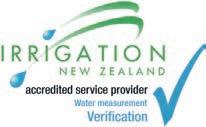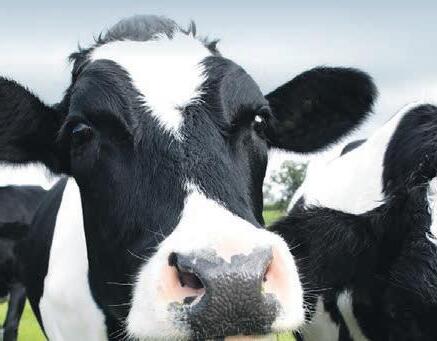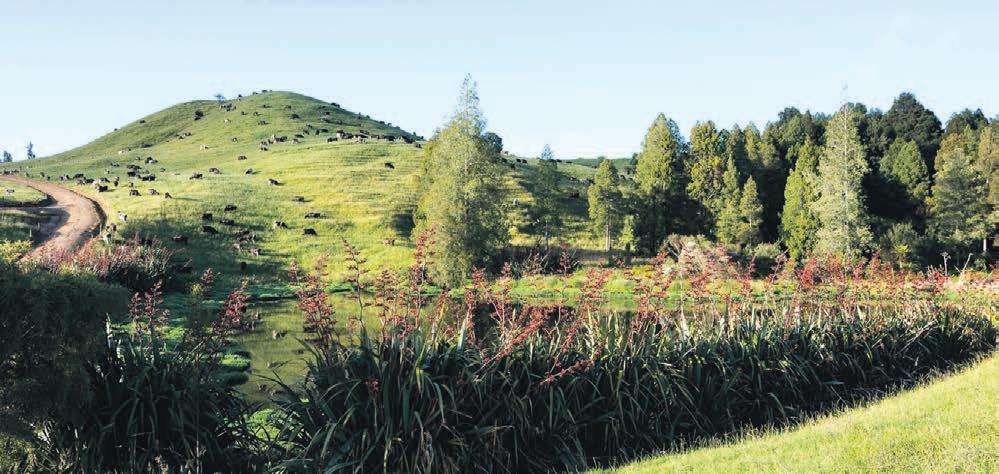FARMING INTO THE FUTURE
Dairy farmers are doing their best in unhelpful conditions
Good past seasons are helping dairy farmers cope with a tough period now, says BakerAg Managing Director Chris Lewis.


A specialist dairy consultant, Chris is editor of Milklines, a monthly report for dairy farmers and rural professionals.


“Everyone enjoyed a particularly good season two seasons ago with high milk prices and the cost of production initially slow to rise.”
This year there are a number of drivers squeezing the industry, Chris says.
“There is a drop in commodity prices, in˜ ation is continuing to push up operating costs to record levels, and interest rates have doubled from where they were two seasons ago.
“Most dairy farmers have been here before, but some new ones are dealing with it for the ÿ rst time.


“Many farmers took advantage of the stronger cash situation two seasons ago to reduce their

debt levels, but right now day to day operating costs have to be pruned hard and there is little room for discretionary spending.”
The weather hasn’t helped dairy farmers either, Chris points out.
“It has been very tough for farmers with extreme wet conditions last spring, and even











in summer and autumn some places struggled with ˜ ooding and heavy soils.

“On the positive side, there has been good late season pasture growth and most still have good supplementary feed on hand.
“Both farmers and cows are wellprepared for winter.”
Chris expects farmers to keep a tight hand on spending for the foreseeable future, with fertilizer and supplementary feed use down to a basic level.
www.age.co.nz Thursday, June 22, 2023 FEATURE SUPPLEMENT 23 FOR All ENQUIRIES CONTACT US ON: PH 06 379 7953 148 BELVEDERE ROAD, CARTERTON Irrigation/Solutions All Pumping Solutions Water Filtration/Pumps Effluent Design/Ponds/ Storage Tanks Installation/Maintenance FOR ALL YOUR ELECTRICAL AND PUMPING REQUIREMENTS Rural, Domestic, Industrial, Commercial EFFLUENT - CUSTOM DESIGNS - Your Needs - Our Solutions - IRRIGATION 2023 DAIRY
2023 DAIRY FARMING INTO THE FUTURE
Here’s to all Kiwi dairy farmers

June the ÿ rst was World Milk Day, celebrating Kiwi dairy farmers’ commitment to reducing their environmental footprint while delivering quality food around the world.
The United Nations’ Food and Agriculture Organisation (FAO) established World Milk Day in 2001 to recognise the importance of milk as a global food and to celebrate the dairy sector.


This year it showcased how dairy is reducing its environmental footprint, while providing nutritious food.
Kiwi dairy farms are the world’s most emissions-e° cient milk producers – with a carbon footprint for on-farm milk production that’s 70 percent lower than the FAO’s global average.
DairyNZ chief executive Dr Tim Mackle says the dairy sector is working hard to keep it that way,
“because a low environmental footprint on-farm is positive for all Kiwis, our customers and the environment.”



To continue the progress, DairyNZ is investing in R&D alongside sector and research partners to build understanding of methanereducing technologies.
“We should all be proud of our dairy farmers for helping maintain New Zealand’s success, producing more environmentally e° cient products while supporting communities and the economy.
“Dairy provides jobs for 50,000 Kiwis and brings in about $22 billion of export earnings a year, which leads to about $50 billion in New Zealand’s economy.”


Kiwi farmers are reducing footprint through good farming practices, including riparian planting and Farm Environment Plans.


The plans allow dairy farmers to identify and manage environmental risks on-farm. Currently, 69 percent of New Zealand dairy farms have Farm Environment Plans. By 2025, they all will.

“However, we know the job is not yet done,” Mr Mackle says. “As a sector, we are committed to further improvement.”




The industry good-body also works closely with local farmer and community groups at a catchment level. This is widely recognised as the way forward in
Unified, index could lift dairy farmers’ profit
A single accurate, independent national animal evaluation index that incorporates genomic information is key to increasing proÿ ts for Kiwi dairy farmers.
We all want BW – and our genetic gain – to be the best it can be for our dairy farmers.

One independent BW, with genomics, will give farmers the most accurate data and lead to the most genetic gain.

NZAEL, a DairyNZ subsidiary, would deliver this single BW system as an industry-good, credible source of data available to everyone.
We believe this will give farmers the most accurate data to compare bulls and cows, building their conÿ dence and increasing genomics use in New Zealand.
improving the environment, as it achieves better results than a national one-size-ÿ ts-all approach.
The Sustainable Dairying: Water Accord has seen 99.8 percent of waterways fenced to exclude dairy cattle, while 100 percent of stock crossing points now have bridges or culverts.

Keeping cows out of waterways is a big part of protecting water. These on-farm actions include good management practices that can minimise sediment and particulate phosphorus loss from land to water.
“The actions clearly demonstrate Kiwi dairy farmers’ commitment to improving the environment – and providing quality food.”
One national animal evaluation index will ensure breeding decisions are made consistently, with economic and environmental beneÿ ts for dairy. There are currently three Breeding Worth (BW) animal evaluation indexes being used in the sector, and they are not all equal.

This creates confusion for farmers around which BW to use and is one of the key reasons why New Zealand’s rate of genetic gain is not improving. Our genetic gain is steady, but we can do better. Slow and inconsistent uptake of genomics has meant our herds have lagged behind those of our

competitors, such as Australia, the UK and the US. We want to change that.
That’s why DairyNZ, through New Zealand Animal Evaluation Ltd (NZAEL), is looking to improve its BW to include genomics.
Genomic information enables early trait predictions and helps dairy farmers make good breeding decisions, to increase the genetic gain of their herds and lift farm proÿ t.
Early trait predictions enable farmers to ÿ nd the best bulls sooner and make better breeding and culling decisions based on trusted information.
The independence of NZAEL


helps give dairy farmers conÿ dence. It aims to ensure the New Zealand dairy herd is resilient and our rates of genetic gain are internationally competitive. That’s our vision.

With that in mind, we propose a BW system that:
• ensures more accurate data is available




• facilitates a combined e˛ ort to improve New Zealand’s dairy herd












• enables better extension on animal evaluation and breeding decisions






• includes genomic information in Breeding Worth calculations.
Under the proposed system, all dairy farmers would have the choice of using this data to improve their herds and lift the performance and proÿ tability of the New Zealand dairy herd.
Understanding farmers’ needs and challenges is key to NZAEL’s work, so we’re seeking dairy farmer feedback on how to ensure our proposed BW system is fair for all users and will help the sector achieve a better rate of genetic gain.
Consultation is underway until June 27 to seek dairy farmer and sector feedback on this proposed operating model over the next six weeks. Visit https:// www.dairynz.co.nz/better-BW to share your thoughts on the proposed BW system.
For more information on NZAEL and its work, visit Animal Evaluation DairyNZ



A utility tractor like you've never known before. The MF Global Series has been re-engineered to meet the needs of present and future farmers.



www.age.co.nz Thursday, June 22, 2023 FEATURE SUPPLEMENT 25 24 FEATURE SUPPLEMENT Thursday, June 22, 2023 Wairarapa Times-Age Look forward with +MORE Grab a coffee with us and see if we’re a good fit. info@plusmore.co.nz 06 929 1068 Our Wa rarapa team of Chartered Accountants & Bus ness Adv sors work w th dairy farmers contract mi kers and sharemi kers nat onw de play ng an integral part n the r rura advisory teams DYNA 4 TRANSMISSION AVAILABLE IN SOME MODELS! LOAD UP & POWER ON WITH HUGE SAVINGS. MF GLOBAL SERIES A utility tractor like you've never known before. The MF Global Series has been re-engineered to meet the needs of present and future farmers. With the Global Series, Massey Ferguson has listened to you at the heart of the design phase and taken the concept of a utility tractor to redesign and re-engineer from the ground up. Manufactured to exact standards, MF Global Series tractors are purpose built in the latest state-of-the-art facilities, combining the very best of today's technologies with comfort, simplicity, reliability and quality. No other range on the market today offers such an array of build speci cations and accessories, all designed to help tailor your machine exactly the way you need it for your farming operation. 300 High Street, Solway, Masterton Shorty 027 294 5010 • James 027 307 2158 06 370 0390 • www.tfmtractors.nz GREEN HARVEST
LOAD UP &
WITH HUGE SAVINGS.
GLOBAL SERIES
T & C's APPLY INTEREST RATE BE QUICK OFFER EXPIRES 30 JUNE 2023!
POWER ON
MF
O.99%
Kiwi farmers are reducing footprint through good farming practices, including riparian planting and Farm Environment Plans.
Genomic information enables early trait predictions and helps dairy farmers make good breeding decisions.
2023 DAIRY FARMING INTO THE FUTURE


Animals are at the heart of wintering
By Justin Kitto, DairyNZ lead advisor –


wintering



We’ve all been feeling the colder weather creep in and, with winter o˝ cially here across the country, farmers are getting ready for the months ahead.
Farmers are passionate about their farms and their animals, no matter the season, and regional councils, MPI and other sector bodies have been recognising farmers’ wintering e˜ orts, including keeping our animals comfortable. Keeping cows comfortable

We know that lying time is important to cows as it provides rest, opportunity to sleep and reduces the risk of lameness, which leads to better welfare outcomes.

When cows are well fed, have suitable soft lying surfaces, space available and are not exposed to adverse weather conditions, they prefer to lie for 10-12 hours per day.

Some great work from the Southern Dairy Hub has shown soil moisture conditions, in particular surface water, results in cows not getting enough lying time.
There are many innovative actions that farmers can use to ensure their cows get su˜ cient lying time, including:
• Shifting cows to drier, lower-risk or sheltered paddocks

Southland dairy farmer Luke Templeton.

• Saving crops positioned in drier or more sheltered areas for grazing during wet weather




• Increasing the feeding area by giving cows a fresh break

• Rolling out straw for cows to lie on
• Providing cows with access to the area behind the back fence (if suitable for lying on).

It is also important to put cows in mobs based on calving dates to help monitor and manage herds. This makes it simpler to move cows o˜ -crop two weeks before calving to provide the best conditions and outcomes for the herd and ensure no calves are born on crop.
Wintering in action
Southland dairy farmer Luke Templeton applies a range of good wintering management practices suited to his farm. He says they always hope for the best over

Helping reduce injuries over calving
winter, but plan for the worst.

“It is never about if we get bad weather, it’s always about when and considering what you will do to look after your animals and your people no matter the weather.”
His animals are checked twice a day to observe the condition of the cows and the ground, including looking for lying bowls where they have gotten comfortable and settled down in more sheltered or warm areas.
Luke says if conditions seem too wet, they use their contingency plan, typically by doing an additional shift of the break fence to provide a fresh lying surface. They also use portable troughs and provide additional feed, such as hay and baleage, along with moving the break fence up to three times a day.
Further information and resources are available at dairynz.co.nz/ wintering




We are 100% New Zealand owned and operated. All of our products are produced from all-natural limestone, quarried right here in Wairarapa. We don’t use unnecessary additives or chemicals and offer both organic and non-organic options.

 By Callum Eastwood, DairyNZ senior scientist
By Callum Eastwood, DairyNZ senior scientist

It’s been great to be able to get out and about more this year, connecting in-person again with farmers at events.
We’ve been talking about a range of topics, but there has been a focus on keeping our sta˜ safe and well by reducing injuries over calving.
Research has shown sprain and strains comprise about 40 percent of all dairy farm injuries, particularly between August and October during spring calving. These mainly occur when farmers are:
• Collecting calves from the paddock
• Lifting/feeding calves buckets of milk
• Cupping cows, particularly on rotaries
• Slipping or tripping on uneven ground or pipes/hoses.



With this focus around on-farm safety, DairyNZ has partnered with ACC through the ACC Workplace Injury Prevention Grants.
Through this we are designing and developing creative solutions with farmers that support a sector-wide reduction in sprains and strains,
particularly during calving.
We know this time of year is busy enough without additional injury to yourself or someone on your team.
DairyNZ is passionate about ensuring solutions that sound good on paper and are practical to implement in real life.
That’s why we co-design innovative farm safety solutions with farmers to understand how to improve safety during day-to-day calving activities.
Farmers are part of the initial designs, and they test all concepts on-farm to further reÿ ne the solutions and determine whether they are practical and help solve the problems identiÿ ed.
It’s been exciting sharing these prototypes with farmers at recent events.

This included showcasing them at the Innovation Hub at Fieldays, which provided a great opportunity for farmers to come and see the concepts in person.
One entry was our easy-entry calf trailer, with a spring-loaded and self-closing saloon door.
This enables easier, faster and safer calf loading, to reduce injuries associated with collecting calves. Other concepts include a calfrearing area pedestrian gate, exible breast rail, new milking cluster design, cups on mat design and bucket-lifting trolley.

While we continue working on trialling and improving our concepts, still encourage you to focus on the physical and mental wellbeing of yourselves and your team over calving.
Here are a few top tips from farmers that can help reduce injury during calving season: have two sta˜ pick up heavier calves together if needed. use a specialised trailer to transport calves pipe milk into calf feeders instead of lifting buckets tuck hoses away after use in the milking shed invest in the right footwear look for great grip and ankle support
More information and videos on the concepts are available at dairynz. co.nz/sprains-strains.






www.age.co.nz Thursday, June 22, 2023 FEATURE SUPPLEMENT 29 28 FEATURE SUPPLEMENT Thursday, June 22, 2023 Wairarapa Times-Age
QUARRY IS OPEN 8AM - 5PM MONDAY - FRIDAY OR BY ARRANGEMENT. 704 Te Wharau Rd, Masterton 0800 879 274 Quarry Manager – Todd Johnson todd@nzaglime.co.nz www.nzaglime.co.nz ENQUIRE NOW ORDERS@MOOREY.CO.NZ 07 888 1955 KILN-DRIED BALED SHAVINGS WOOD CHIP Langlands Motorcycles Limited MASTERTON www.langlandshonda.co.nz 11 Chapel Street P: 06 378 8444 GREYTOWN 2491 State Highway 2 P: 06 304 8482 Terms and Conditions apply, see in store for details
Easy-entry calf trailer in use
Research has shown sprain and strains comprise about 40 percent of all dairy farm injuries





















































































